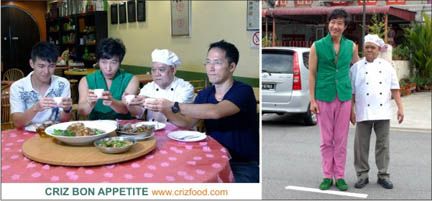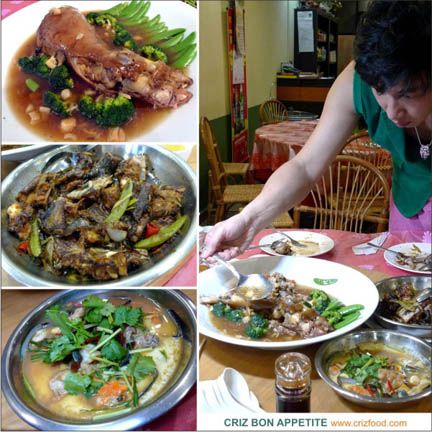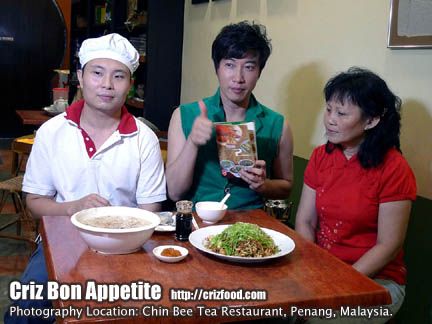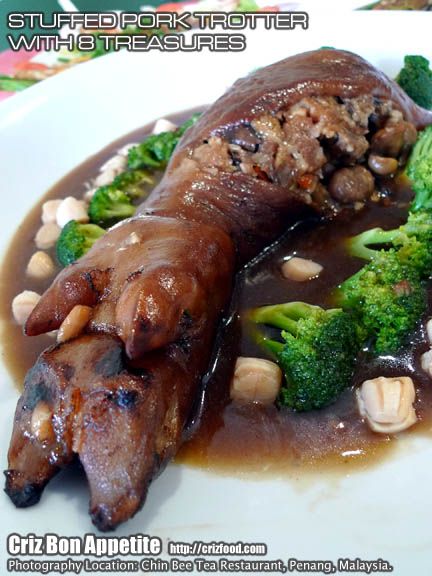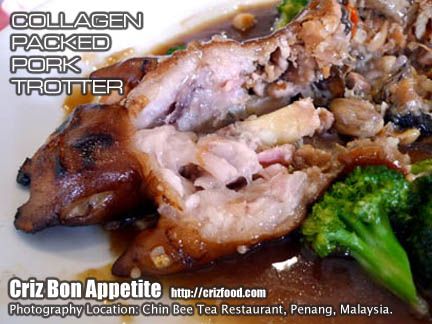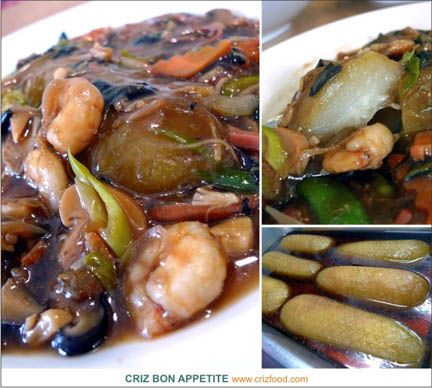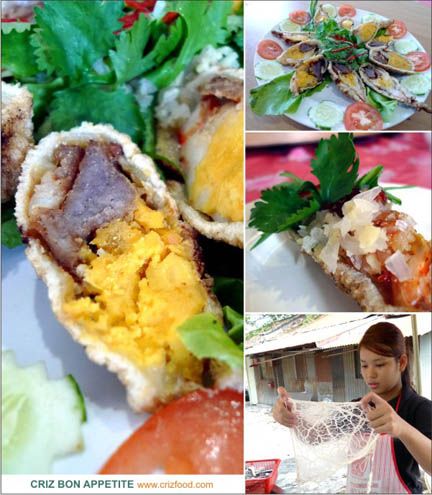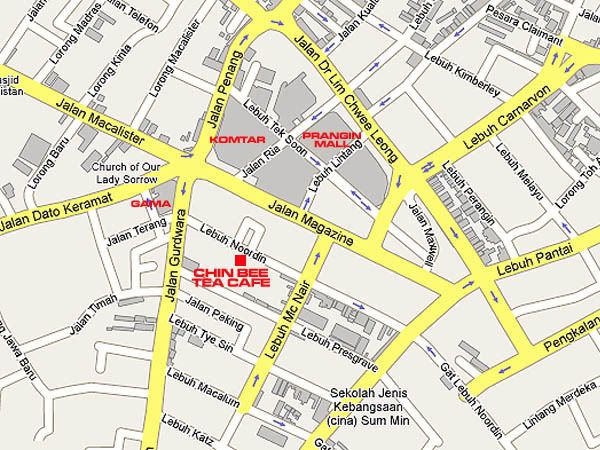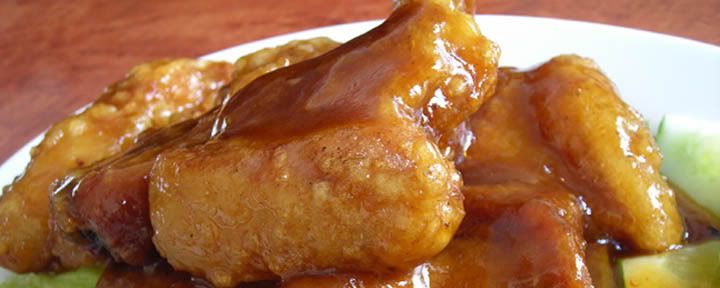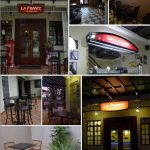During the recent Penang Food Hunting Trip 2011, organized by Food Digest Magazine, Malaysia’s No. 1 food and lifestyle magazine, Taiwanese Celebrity Chef Chen Hong (陳鴻), together with renowned Chef Park Tae Yeong (from Korea) and Chef Billy Ng Yih Lee (runner-up of 8TV’s Hot Chef Season One) were bought to a little Chinese restaurant down town in the heart of Georgetown, Penang. The restaurant by the name of Chin Bee Tea Restaurant, coincidentally, was also my most recommended restaurant in 2009 as well as in 2010. The chefs were glad that they had the privileges to meet up with the last remaining of the top few Chinese cuisine chefs in Penang, Sifu Malai Chong, 68 years old. With over 5 decades of cooking experiences locally and internationally, the Sifu managed to capture the chefs’ hearts with his creative culinary skills and dishes.
Three signature dishes from the old chef’s own creation were presented namely the Stuffed Pork Trotter with Eight Treasures (八寳豬手 – RM80nett), Dry Fry Grouper Head (生炒石斑魚頭 – RM30nett) and Five Continents Under the Moonlight (月光照五洲 – RM30nett). All the chefs were impressed with the “Stuffed Pork Trotter with Eight Treasures” as it was rich in flavors and without the strong pork smell, evidently stated by Chef Chen Hong during his audio interview with the bloggers. He even tried to survey more on the ingredients used in the dish. I’ll brief more on the ingredients and preparations in our recent interview with the Sifu below. The “Dry Fry Grouper Head”, on the other hand, was specially marinated in the chef’s secret sauce and dry fried in the fish’s own juice, WITHOUT ANY DROP OF WATER. It had some vegetables such as carrots, onions, snow peas and the pungent taste from the added chilies. The “Five Continents Under the Moonlight” was actually the chef’s smooth and silky steamed egg with five different types of toppings, namely mussels, prawns, grouper fillets, squids and century eggs.
Other than the three main dishes, Chef Chen Hong was also introduced to two of their signature noodle dishes such as the Hong Tu Mien (鴻圖面) which had Ee Foo Noodles (伊麵), in a sharksfin soup like broth with chopped prawns, chicken slices and eggs, served with black vinegar and the Gui Hua Mien (桂花麵) which also had Ee Foo Noodles but stir fried with a generous amount of crab meat, scallops, prawns and egg, garnished with lots of sliced lettuce, served with the chef’s own concocted fragrantly fried chili paste (sambal).
In a recent interview with Sifu Malai Chong, we had the Stuffed Pork Trotter with Eight Treasures (八寳豬手 – RM80nett) recreated to check out what made Chef Chen Hong so impressed with this dish. I would say I was as equally impressed as the chef with the rich taste and quality of the ingredients within the stuffed pork trotter.
The Sifu had really put in all his time, effort and passion into this dish and at RM80nett, this is super cheap. To get rid of the normal strong pork smell, the pork trotter was soaked and washed many times. After ridding of the excess water, a layer of seasoning was applied to the trotter and then deep fried to perfection. When cool down, the Sifu carefully deboned the trotter, while reserving the meaty parts to be added back into the dish. The stuffing actually consisted of a combination of stir fried meat cubes from the trotter (豬手肉) plus eight other treasures such as scallops (乾貝), sea cucumber (海参), mushrooms (花冬菇), Chinese water chestnuts (馬蹄), Chinese chestnuts (栗子), lotus seeds (蓮子), carrots (紅蘿卜) and glutinous rice (糯米). These stir fried ingredients were then stuffed back into the deboned trotter, sewn up and steamed up to 6 hours. The remaining juice from the steamed trotter together with some corn flour, dashes of Shao Xing wine would then be used to make the gravy with some additional pre-marinated steamed scallops. The taste of the filling was like the Chinese savory dumpling, rich and delicious. You would need to order this dish in advance to avoid disappointment.
You can have a look at how many bones there were left on trotter. There was only one left and the rest are just cartilages, full of collagen, a protein that is commonly found in the body of mammals. It’s believed to slow down the aging processes and keep you young although there’s no proven medical research that it would really help. It’s just a trend, especially amongst the ladies who would want to try out anything just to be wrinkle free. Anyway, collagen is harmless as it would just break down into amino acid just like any other protein.
Here’s a short video on the interview with Sifu Malai Chong by our podcaster, Mr. Willy Wah. It’s in Cantonese and is up in Mobile Radio Hong Kong now.
The chef also came out with two more of his self created dishes. One of them was the funny named Granny Asking Direction (婆婆問路 – RM20nett) which I had introduced last year. It’s a poor man’s way of having an expensive sea cucumber dish. The Sifu steamed the fuzzy melon/squash (毛瓜/mo kua) in thick broth (上湯) and seasoning to make the melon looked just like sea cucumbers and the dish had some seafood, vegetables, mushrooms, scallops and sliced chicken sausages. The whole presentation was rather exclusive. This dish would suit the elderly too as the “sea cucumber” aka melon would not be as tough as the real one. Moreover, the thick gravy matched well with the rest of the ingredients.
The next dish also had a bombastic name – the Iron Net Golden Dragon (鐵網金龍 – RM3.50nett/pcs, Min order 2 pieces). It’s even cheaper than most of the Thai items I had tried before. As for this dish, there was again the hardship in getting the dish out as it was not as simple as it looked to get that shape. Each piece would be molded into a pear-like shape with a “dragon” aka prawn wrapped with salted duck egg and “gold nugget” (金錢肉) as the ones I normally get from Choo Choo Heng during Chinese New Year. This shaped item would then be rolled into some frying flour, wrapped in the chef’s secret “iron net” and then rolled again into frying flour prior to being deep fried. The secret “iron net” which is actually a pig’s caul fat netting (猪油網), a very thin lacy membrane that surrounds the viscera of a pig, is a traditional Chinese way of containing a loose product prior to deep frying. It shaped the product when the fat melts away, leaving that extra fragrant that would be simply delicious. The end products were sliced into halves and served with some coriander, chopped pickled ginger (調味醋姜片), pickled Rakkyo bulbs (酸甜蕎頭) and Thai chili sauce.
If you are coming from Trader’s Hotel along Jalan Magazine, keep to your left and drive on until you have reach the second traffic light. Turn into the first road on your left (Jalan Gurdwara – left of the Gama Supermarket) and then the first left turning into Lebuh Noordin. The shop is just somewhere in the middle on your right within a row of heritage houses. In fact, this shop is just two houses away from another recommended confectionery manufacturer by the name of Hock Lok Siew Biscuit Trading. Please make sure you call up for reservation as this place could be packed during lunch or dinner hours.
Name: CHIN BEE TEA CAFE
Address: 124, Lebuh Noordin, 10300 Penang, Malaysia.
Contact: 604-261 1761, 012-499 9972 (Mr. Ong)
Opening Hours:
12noon – 3.00pm, 6.00pm-9.30pm (Closed Alternate Wednesday)
GPS: 5.412361, 100.329541
RATING:
Ambience: 8/10 (1-4 cheap, 5-7 average, 8-10 classy)
Food Choices: 9/10 (1-4 limited, 5-7 average, 8-10 many choices)
Taste: 10/10 (1-4 tasteless, 5-7 average, 8-10 excellent)
Pricing: 8/10 (1-4 cheap, 5-7 average, 8-10 expensive)
Service: 9/10 (1-4 bad, 5-7 average, 8-10 excellent)
